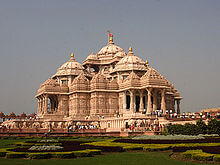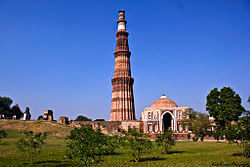About New Delhi
Delhi is said to be the heart of India. Of course it is which stores within itself the past glory of seat of empires & astonishing monuments and rich & diverse culture of true India. Delhi is sprinkled with dazzling gems like magnificent monuments, fascinating museums, art galleries, architectural wonders, fabulous eating places and bustling markets.
Delhi is well connected, by a network of roads and national highways, with all the major cities in India. The three major bus stands in Delhi are Inter State Bus Terminus (ISBT) at Kashmiri Gate, Sarai Kale-Khan Bus Terminus and Anand Vihar Bus Terminus. Both the government and private transport providers provide frequent bus services. One can also avail prepaid and private auto and taxi services here.
The railway network connects Delhi to the all major and nearly all minor destinations in India. The three important railway stations of Delhi are New Delhi Railway Station, Old Delhi Railway Station and Hazrat Nizamuddin Railway Station. Within Delhi, one can also make use of Metro to travel to various places. Delhi Metro also connects the New Delhi Railway Station and Airport to the city.
Delhi is well connected with domestic and international flights, to all major cities within and outside India. Almost all the major airlines have their flights operating from Indira Gandhi International Airport at New Delhi.
Distance of Venue (Vigyan Bhavan) from Indira Gandhi International Airport = 20km
Distance of Venue (Vigyan Bhavan) from Inter State Bus Terminal (ISBT) = 10km
Little demographic information about Delhi:
Area: 1,483 sq km
Latitudinal parallel: 28.3oN
Longitudinal meridian: 77.13oE
Altitude: 293 m above sea level
Population: 13.85million (Census 2001)
Average Temperature: 45oC (Max) - usually in May-Jun, 5oC (Min) - usually in Dec-Jan
Desirable Clothes: Woollen for winters and light cotton for summers
Rainfall: 714 mm
Monsoon: July to mid-September
Population: 13.85 (Census 2001)
Season: Extreme climate with very hot summer and very cold winter
Best time to visit: October to March
STD Code: 011
Languages: Hindi, English, Urdu and Punjabi
Around Delhi
 Akshardham is a Hindu temple complex in Delhi, India. Also referred to as Delhi Akshardham or Swaminarayan Akshardham, the complex displays millennia of traditional Indian and Hindu culture, spirituality, and architecture. The building was inspired and moderated by Pramukh Swami Maharaj, the spiritual head of the Bochasanwasi Shri Akshar Purushottam Swaminarayan Sanstha, whose 3,000 volunteers helped 7,000 artisans construct Akshardham.
Akshardham is a Hindu temple complex in Delhi, India. Also referred to as Delhi Akshardham or Swaminarayan Akshardham, the complex displays millennia of traditional Indian and Hindu culture, spirituality, and architecture. The building was inspired and moderated by Pramukh Swami Maharaj, the spiritual head of the Bochasanwasi Shri Akshar Purushottam Swaminarayan Sanstha, whose 3,000 volunteers helped 7,000 artisans construct Akshardham.
The temple, which attracts approximately 70 percent of all tourists who visit Delhi, was officially opened on 6 November 2005. It sits on the banks of the Yamuna.
 The Qutub Minar is a tower located in Delhi, India. It is the world's tallest brick minaret with a height of 72.5 meters (237.8 ft)[citation needed]. Prithviraj Chauhan built Qutub minar for his daugther to see Yamuna, but later, Construction commenced by Qutb-ud-din Aibak who won Delhi from Prithviraj under Muhammad Ghori as his commander in chief, and finished by Iltutmish[citation needed]. The Qutub Minar is notable for being one of the earliest and most prominent examples of Indo-Islamic architecture. It is surrounded by several other ancient and medieval structures and ruins, collectively known as Qutub complex.Qutab Minar is the nearest station on the Delhi Metro.
The Qutub Minar is a tower located in Delhi, India. It is the world's tallest brick minaret with a height of 72.5 meters (237.8 ft)[citation needed]. Prithviraj Chauhan built Qutub minar for his daugther to see Yamuna, but later, Construction commenced by Qutb-ud-din Aibak who won Delhi from Prithviraj under Muhammad Ghori as his commander in chief, and finished by Iltutmish[citation needed]. The Qutub Minar is notable for being one of the earliest and most prominent examples of Indo-Islamic architecture. It is surrounded by several other ancient and medieval structures and ruins, collectively known as Qutub complex.Qutab Minar is the nearest station on the Delhi Metro.
 The Bahá'í House of Worship in Delhi, India, popularly known as the Lotus Temple due to its flowerlike shape, is a Bahá'í House of Worship and also a prominent attraction in Delhi. It was completed in 1986 and serves as the Mother Temple of the Indian subcontinent. It has won numerous architectural awards and been featured in hundreds of newspaper and magazine articles.
The Bahá'í House of Worship in Delhi, India, popularly known as the Lotus Temple due to its flowerlike shape, is a Bahá'í House of Worship and also a prominent attraction in Delhi. It was completed in 1986 and serves as the Mother Temple of the Indian subcontinent. It has won numerous architectural awards and been featured in hundreds of newspaper and magazine articles.
 The India Gate is the national monument of India. Situated in the heart of New Delhi, India Gate was designed by Sir Edwin Lutyens, inspired by Arch de Triumph in Paris. It was built in 1931. Originally known as All India War Memorial, it is a prominent landmark in Delhi and commemorates the 90,000 soldiers of the Indian Army who lost their lives while fighting for the Indian Empire, or more correctly the British Raj in World War I and the Third Anglo-Afghan War. It is composed of red and pale sand stone and granite.
The India Gate is the national monument of India. Situated in the heart of New Delhi, India Gate was designed by Sir Edwin Lutyens, inspired by Arch de Triumph in Paris. It was built in 1931. Originally known as All India War Memorial, it is a prominent landmark in Delhi and commemorates the 90,000 soldiers of the Indian Army who lost their lives while fighting for the Indian Empire, or more correctly the British Raj in World War I and the Third Anglo-Afghan War. It is composed of red and pale sand stone and granite.
Originally, a Statue of King George V had stood under the now-vacant canopy in front of the India Gate, and was removed to Coronation Park with other statues. Following India's independence, India Gate became the site of the Indian Army's Tomb of the Unknown Soldier, known as Amar Jawan Jyoti (The flame of the immortal soldier).
Climate
Delhi features an atypical version of the humid subtropical climate (Köppen Cwa). Summers are long and extremely hot, from early April to mid-October, with the monsoon season in between. Early March sees a reversal in the direction of wind, from the north-western direction, to the south-western. These bring the hot waves from Rajasthan, carrying sand and are a characteristic of the Delhi summer. These are called loo. The months of March to May see a time of hot prickling heat. Monsoon arrives at the end of June, bringing some respite from the heat, but increasing humidity at the same time. The brief, mild winter starts in late November and peaks in January and is notorious for its heavy fog.
Extreme temperatures range from −0.6 °C (30.9 °F) to 46.7 °C (116.1 °F). The annual mean temperature is 25 °C (77 °F); monthly mean temperatures range from 13 °C to 32 °C (56 °F to 90 °F). The average annual rainfall is approximately 714 mm (28.1 inches), most of which is during the monsoons in July and August. The average date of the advent of monsoon winds in Delhi is 29 June.
| Climate Data for Delhi | ||||
|---|---|---|---|---|
| Month | Oct | Nov | Dec | Year |
| Average high °C (°F) | 32.9 (91.2) | 28.3 (82.9) | 23.0 (73.4) | 31.4 (88.5) |
| Average low °C (°F) | 19.5 (67.1) | 12.8 (55) | 8.2 (46.8) | 18.8 (65.8) |
| Rainfall mm (inches) | 36.3 (1.429) | 5.0 (0.197) | 7.8 (0.307) | 797.3 (31.39) |
| Avg. rainy days | 1.6 | 0.1 | 0.6 | 39.1 |
| Sunshine hours | 269.7 | 246.0 | 217.0 | 2,688.4 |
Famous for its mixture of historic landmarks, monuments, temples and stylish Art Deco style buildings, the city of New Delhi is filled with interest. Amongst the most notable landmarks within New Delhi are the India Gate, the Lotus Temple (Bahai Temple) and also the President House (Rashtrapati Bhavan).
No trip to New Delhi is complete without a photo or two of its famous Red Fort (Lal Qila), which features a stunning red facade and evening light shows. Just across from the Red Fort is the Raj Ghat, an official memorial to India's spiritual leader, Mahatma Gandhi. New Delhi's main monuments and landmarks are described below.
10 Famous shopping malls in NCR:
- DLF Place, Saket
- Select City Walk, Saket
- Ambience Mall, Vasant Kunj
- DLF Promenade, Vasant Kunj
- Shoppers Stop, Rajouri Garden
- Pacific Mall, Tagore Garden
- DLF Emporio, Vasant Kunj
- Ansal Plaza, Khel Gaon
- West Gate Mall, Rajouri Garden
- The Grate India Palace Mall, Noida
- Ambience Mall, Gurgaon
10 Famous restaurants and food courts in NCR:
- Bukhara, The ITC Maurya
- Big Chill Cafe, Khan Market
- Royal China, Nehru Place
- Moti Mahal Deluxe, GK 1
- Smoke House Grill, Vasant Kunj
- Spaghetti Kitchen, Saket
- Punjab Grill by Jigs Kalra, Saket
- The Yellow Chillies by Sanjeev Kapoor, Sec 18, Noida
- The Clay Ovens, Green Park
- Haldirams, MCIE, Mathura Road